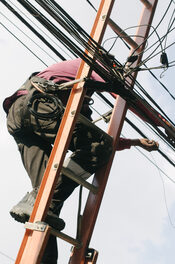 Over the past 18 months or so, the world’s focus has been on the coronavirus pandemic and how to keep everyone safe. Many businesses have paused or ceased operations during this time with workers furloughed or working from home.
Over the past 18 months or so, the world’s focus has been on the coronavirus pandemic and how to keep everyone safe. Many businesses have paused or ceased operations during this time with workers furloughed or working from home.
But despite the obvious reduction in numbers of people at work, we have seen from figures published by the HSE recently, that workplace fatalities during 2020/21 have risen. 142 workers were killed compared to 113 in 2019/20 – a 26% increase year on year.
Falls from height are once again the biggest cause of workplace fatalities accounting for 25% of all deaths. It’s as important now as ever to ensure all those who work at height are trained and competent and that when undertaking work, a safe system of work is to be followed from developing a risk assessment.
According to the work at height regulations, if work at height needs to be undertaken a hierarchy of controls must be followed:
- Avoid –
- Avoid working at height. Employ systems to achieve the task without exposure.
- Roof inspections could be conducted using a camera and telescope pole or drone.
- Prevent –
- Conduct the task using collective measures (MEWPs, scaffold edge protectors)
- Provision of suitable work equipment to prevent a fall from occurring
- Work restraint or work positioning
- Minimise
- Provision of equipment to minimise the distance and consequences of a fall.
- Safety nets, airbags and personal equipment can be used. Training and supervision are essential.
Whilst working at height accounted for 35 deaths last year, other causes of fatal accidents were:
- Struck by a moving vehicle – 25 deaths
- Struck by a moving object – 17 deaths
- Trapped by something collapsing/overturning – 14 deaths
- Contact with moving machinery – 14 deaths
The Management of Health and Safety at Work Regulations require all UK businesses to have a health and safety policy and have completed risk assessments that cover significant health and safety risk.
The CDM Regulations 2015 (regulations 27 & 28) also apply to construction sites regarding the safe use of vehicles. Most deaths (39) last year occurred in the construction industry.
Given 25 workers were killed by a moving vehicle and 14 more due to contact with moving machinery, the need to have traffic management risk assessments and plans in place is essential to ensure vehicle/pedestrian interface is suitably managed. There is obvious greater risk where large vehicles operate, especially if they do so in restricted areas and shift start/end times. It is good practice to complete a workplace traffic risk assessment which should be reviewed periodically and more often if any significant changes occur such as construction on-site, traffic (vehicle and pedestrian) routes etc. This should consider the hazards such as vehicle to pedestrian impact; vehicle to vehicle impact; vehicle to infrastructure impact and personal safety in relation to adverse weather conditions or inadequate lighting.
When a hazard cannot be eliminated, other measures for reducing risk should be considered. So, it is also important to have guards, protective devices and associated control systems for machinery and moving parts to improve the safety of machinery and those operating it in the workplace. The greater the risk, the greater the need to protect against it. Sadly 17 deaths were recorded last year from workers killed due to being struck by a moving object.
The specific statutory regulations which cover work equipment are the Provision and Use of Work Equipment Regulations (PUWER) 1998, although it is also influenced by the Supply of Machinery (Safety) Regulations 2008. Employers have a duty to procure equipment; provide information about the equipment; ensure competence and; use and maintain equipment, in a safe manner. Where machinery has dangerous parts, access should be prevented by guards and access controlled by supervision and information. There should also be detailed operational procedures and instructions relating to the competence requirements to use and maintain work equipment that has significant risk and employees should be authorised and made aware of the equipment they can use following training and competency procedures.
Identifying and monitoring safe systems of work will help to reduce the risk of such catastrophic events occurring and safeguard compliance.